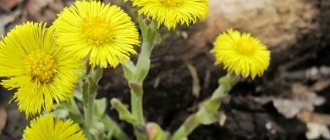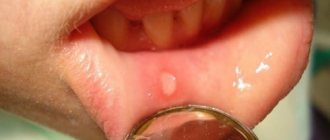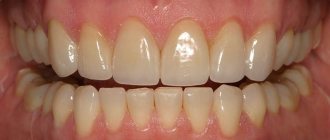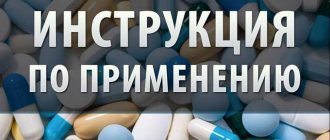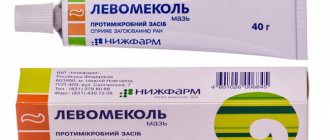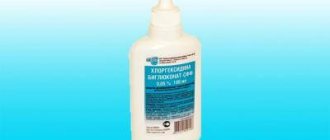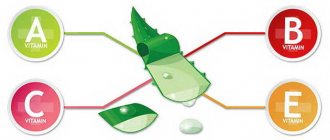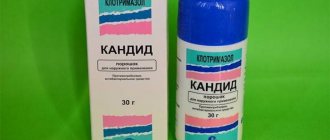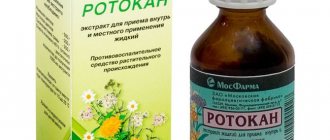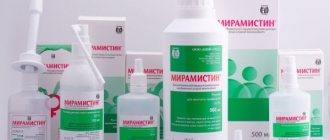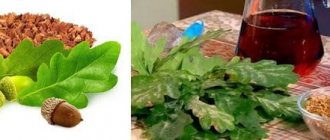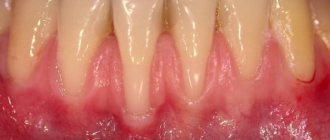"Malavit" composition:
- purified ionized water;
- glycerin;
- copper sulfate and carbon dioxide;
- stone oil;
- gum;
- food lactic acid;
- resins of Siberian cedar and fir;
- mumiyo;
- pine and birch bud extracts;
- oak bark;
- chagi;
- herbal extracts (elecampane, mint, sage, echinacea, etc.).
There are more than 100 ingredients in the solution. “Malavita” does not contain alcohol, preservatives or dyes, due to which it has a minimum of contraindications and side effects.
Find out about the causes and methods of treating black plaque on the tongue in adults and children.
Effective methods for treating inflammation of the dental periosteum are described on this page.
Thanks to its healing natural ingredients, the drug allows you to:
- accelerate healing and restoration of soft tissues due to injuries, burns and other injuries;
- relieve pain and relieve itching;
- reduce swelling and reduce inflammation;
- restore tissue functionality;
- increase local immunity;
- speed up metabolic processes;
- eliminate bad breath.
The solution acts as a tonic.
“Malavit” is stored in a dry room at +5-25 °C. Shelf life 24 months. A solution diluted with water cannot be used after 24 hours. A slight appearance of sediment in the solution and slight turbidity are acceptable.
Indications for use in dentistry
Due to its antiseptic and disinfecting abilities, and the ability to cope with various types of infections, Malavit is effectively used as a component of complex treatment of acute inflammatory processes, including purulent ones.
The product actively acts against viruses, eliminating the symptoms they cause. The use of the solution does not cause resistance to it on the part of pathogenic organisms.
In complex treatment, “Malavit” is used for dental diseases:
- stomatitis of various etiologies;
- periodontitis;
- flux;
- periodontal disease;
- gingivitis;
- tissue injuries due to various reasons.
The solution can be used as an independent medicine:
- damage to the mucous membrane caused by exposure to contrasting temperatures (hot or cold);
- subcutaneous effusions of blood (hematomas);
- vascular damage;
- disruption of local blood flow;
- inflammation caused by insect bites.
Contraindications
It is strictly forbidden to take the drug orally. There is also no need to use Malavit if you are individually intolerant to its components. Do not simultaneously apply Malavit and other local preparations to the affected areas. Skin reaction can be unpredictable.
What is the difference between a dentist and a dentist? Read an interesting article.
How to treat trigeminal neuralgia? Effective methods are described on this page.
Follow the link and read the instructions for using sage herb for oral diseases.
Tablets and antifungal drugs
Iodinol (blue iodine)
When treating advanced forms of the disease, one cannot do without the use of tablets and antifungal drugs. They have a systemic effect on the human body, reduce inflammation, and promote a speedy recovery.
Among the most popular antibiotics are amoxilav, sumamed, flexmoxin solutab. Additionally, the doctor may prescribe anti-inflammatory drugs - imudon, methyluracil, biseptol.
Used in the treatment of candidal stomatitis. Its effectiveness is questionable. The course of treatment with nystatin is quite long. There are alternative modern drugs that help the patient recover faster.
Fluconazole
A strong antimycotic drug that is effective in the treatment of candidiasis. Fluconazole is prescribed 100 mg per day for 7-14 days for all forms of the disease. For recurrent stomatitis, pulse therapy is used - 150 mg once a week.
Lizobact lozenges are used for stomatitis, sore throat, and tonsillitis. They have local antimicrobial and antiseptic effects. Prescribed for adults and children over three years of age. Take according to instructions.
Streptocide
Quite rarely used in the treatment of stomatitis due to its dubious effectiveness. Pour streptocide, ground into powder, onto a cotton swab, apply to the sore, and hold for 30 minutes. It is advisable not to swallow.
The antifungal drug Candide prevents the proliferation of fungi. It is prescribed for the treatment of candidal stomatitis. The solution is applied to the affected surface 3-4 times a day until complete recovery.
To treat stomatitis in adults prone to allergic reactions, antihistamines are prescribed - blockers of histamine H1 receptors.
"Tavegil": one tablet per dose or 2 milligrams per injection. "Claritin": one tablet or 10 milliliters of syrup per dose. "Diazolin": orally 100 milligrams per dose.
Instructions for use
For use in dental practice, Malavit must be used in diluted form. The mucous membranes of the oral cavity are very delicate. Using a concentrated solution can harm them and cause even greater irritation. The proportions may be different (1:5, 1:10, 1:20), depending on the severity of inflammation and the nature of tissue damage. Usually the product is diluted in a glass of water. Before diluting with water, the bottle with the solution must be shaken.
You can use the solution as a mouth rinse or make applications. For rinses, 7-10 drops of Malavita per 100 ml of water are often sufficient. Rinsing is carried out 2 to 5 times a day. For children, the dosage should be less. It must be determined by the doctor, taking into account the age and condition of the small patient.
The solution can be applied to the periodontal mucosa in the form of applications. To do this, “Malavit” is diluted with glycerin (1:1, 1:2), moistened with a cotton swab and applied to the affected area.
If tooth resection (extraction) was performed, then to speed up the healing of the gums, relieve pain and stop bleeding, you can make a bath. Dilute Malavit with water 1:20 and keep on the affected area for 5-6 minutes. After several treatments throughout the day, the unpleasant symptoms should go away.
A short list of effective medications
List of the most effective pharmaceuticals:
- Aekol. This product was created for the treatment of gynecological and surgical pathologies, since Aekol is not directly related to dentistry. The essence of the medicinal effect is the activation of regenerative processes in the oral cavity. Thanks to this, the drug can be an excellent help, but only as part of complex treatment - it has neither anti-inflammatory nor antiseptic effects. The medicine contains vitamins and vitamin-like complexes. The medication is absorbed into the bloodstream, so the dosage must be strictly observed. It is acceptable to use in adults and children, even one year old and infants. The method of application is as follows: take a full cap of the solution, dilute it with half a glass of warm water. Stir thoroughly. Rinse your mouth twice a day. For children who are not able to rinse on their own, the treatment is carried out by adults using a cotton pad.
- Rotocan in pharmaceutical solution form. Rotokan is a natural phytotherapeutic agent with high medicinal activity. The drug is considered completely natural due to the content of chamomile, calendula and yarrow extracts. The medication has a pronounced effect in relieving inflammation, has an antiseptic effect, normalizes metabolism in the area of affected mucous membranes, helps relieve pain, activates the regenerative processes of epithelial tissues and scarring of painful aphthae. Since such a drug is made on the basis of medicinal herbs, it should be used with caution, especially if we are talking about a child or teenager. It is quite possible to develop allergic reactions to the components of Rotokan. The method of application is as follows: take a full teaspoon of the medicine, dilute it with a glass of warm water. Stir thoroughly. Rinse your mouth three times a day. The proportion must be strictly observed, otherwise chemical burns may develop. Rotokan can be used as a monotherapeutic drug.
- Miramistin. It was originally created for the needs of venereology and dermatology as a powerful antiseptic. Suitable for use in adults and children over one and a half years old. The drug is not absorbed into the bloodstream, therefore it is considered safe even for independent use. Helps relieve inflammation, destroys pathogens (bacteria), and also inhibits the genetic material of the herpetic pathogen, which often becomes the causative agent of aphthous stomatitis. Miramistin destroys cell walls and membranes of infectious agents. In addition, it has an antifungal effect, killing candida microorganisms. Directions for use in adults: take a teaspoon of solution, dilute it with half a glass of water (about 150 ml). Rinse your mouth for stomatitis three to four times a day half an hour before your next meal. Otherwise, the therapeutic effect will be minimal or disappear completely. When used in a child, it is recommended to halve the dose. Dental lesions should be treated for 5-7 days.
- Nystatin. It is a broad-spectrum antibacterial drug with a predominantly antifungal effect. Effectively helps fight fungal (candida) forms of stomatitis. However, the drug is not suitable for self-treatment. It is prescribed only in combination, since it has neither anti-inflammatory nor other effects. It is a highly specialized medicine. Since the drug belongs to the group of antibiotics, it must be used with great caution and only in strict accordance with the instructions. To prepare the solution, it is recommended to grind one Nystatin tablet into powder and add a glass of water. The mouth should be rinsed thoroughly. Repeat three times a day. The use of the drug is strictly prohibited for persons suffering from damage to the liver, kidneys, or pancreas. Prescribed with caution to young patients (not suitable for children under three years of age). It is acceptable to take tablets orally.
- Chlorophyllipt. A drug that has proven its effectiveness against infectious (bacterial) stomatitis. The medicine contains extracts of eucalyptus leaves. Essential oils, which form the basis of the medicine, effectively fight inflammation, infectious agents and pathogenic microflora. However, eucalyptus is known to have a high allergenic potential. Before use, it is recommended to apply a small drop of the solution to the skin (first diluting the product with water in the amount of a teaspoon to avoid burns). Observe for 20 minutes. If there is no redness, there is no allergy. The drug should be used with caution. Chlorophyllipt is contraindicated for use in children under 12 years of age. To achieve a therapeutic effect, you need to dilute the lid of the product with half a glass of water. Rinse twice a day. You can rinse your throat with a syringe twice a day.
- Chlorhexidine. Available in the form of a concentrated preparation for dilution with water or alcohol. To prepare an antiseptic, you need to dilute 10 drops of Chlorhexidine with a glass of water. The method of application involves treating the affected mucous membranes three times a day. It is often not recommended because the medication is highly toxic. Chlorhexidine is included in many medications as a powerful antiseptic. Used as part of systematic therapy. It is not advisable to use Chlorhexidine on your own, at home. The medicine is contraindicated for children under 12 years of age. It normalizes local metabolism, increases focal immunity and helps reduce the course of the disease by almost one and a half times. Stomatitis mash is used 3-4 times a day in concentrated form to lubricate the foci of stomatitis. Appointed from the age of one year.
We suggest you read: How and with what to treat stomatitis? Symptoms and causes
Stomatitis is an infectious and inflammatory disease that affects the mucous membrane. The formation of inflammatory foci in the form of ulcers, erosions, blisters, cheesy plaque is the body’s response to the invasion of the pathogen: candida fungi, viruses, allergens or bacteria.
In addition to inflammatory formations, you can expect symptoms such as acute pain, swelling of the affected surface of the mouth, unpleasant smell and taste, and increased body temperature. What other signs are accompanied by the disease can be found in the article “Stomatitis in adults: symptoms and treatment.”
Different forms of the disease
Let's look at how to treat stomatitis in adults.
Cost and analogues
In pharmacy chains "Malavit" can be purchased from 185 rubles. Unfortunately, there are no absolute structural analogues of the solution. But if necessary in dental practice, it can be replaced with agents similar in pharmacological action:
- Septisol is an external herbal solution containing many of the components found in Malavit. It has a complex effect on tissue: accelerates healing, relieves pain, relieves inflammation, etc.
- Tandum verde is a solution for local treatment of the oral cavity for dental and ENT diseases.
- Stomatofit is an oral solution based on herbal extracts (chamomile, oak bark, mint, arnica).
- Maraslavin is a brick-red antiseptic solution consisting of plant extracts of herbs.
- Tonzinal is a preparation with extracts of St. John's wort, calendula, rose hips, licorice, as well as vitamin C and eucalyptus ester.
“Malavit” is a solution that has become very widespread in cosmetology and medical practice. Its beneficial properties help to cope with a number of dental ailments associated with periodontal damage. Before using this dietary supplement, you should consult your doctor about the need for such treatment and dosage of the drug.
You can also find out about other medicinal pharmaceutical products for diseases of the oral cavity on our website. Malavit solution instructions for use and price are given to you.
Treatment of advanced bacterial form
Treatment of the mouth for advanced bacterial stomatitis is carried out using antibacterial agents. "Faryngosept": 1 lozenge per dose. “Evkarom”: 2 briquettes are poured with 500 milliliters of boiling water, brought to a boil, removed from the heat and inhaled for about 10 minutes. The remaining infusion can be filtered and used for rinsing.
Miramistin is another effective remedy for bacterial stomatitis. The drug also fights the activity of fungi and viruses. The solution can be used to irrigate the oral cavity or make applications.
We invite you to read: ᐉ How to brush your teeth with the Air Flow system (Air Flow) - Full overview of the pros and cons
In advanced cases, stomatitis is treated with antibiotics. “Amoxiclav”, “Amoxicillin”, “Ampicillin”, “Azithromycin”: 1-2 tablets per dose.
If the prescribed therapy turns out to be effective, the patient’s well-being returns to normal. However, you cannot stop treatment at this stage. The mucosal tissues that have not yet healed can be attacked again by any pathogen that causes stomatitis. This is fraught with relapses of the disease, which we discussed in the article “What is recurrent stomatitis.”
Regenerating medications for stomatitis in adults will help complete therapy: Solcoseryl ointment, oil solutions Karatolin, Aekol, Vitaon balms, Shostakovsky (vinyline), sea buckthorn oil.
Sea buckthorn oil
